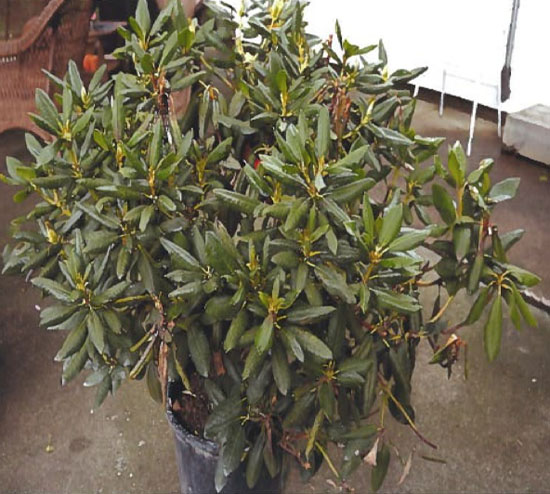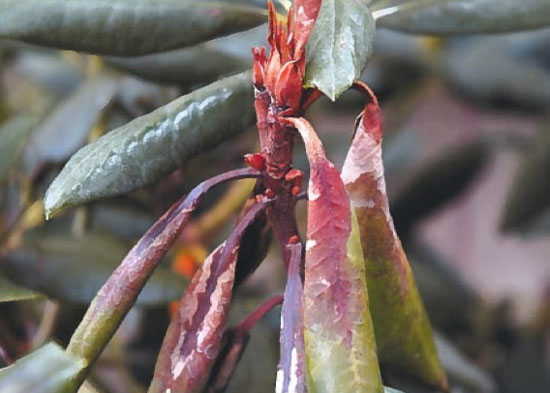Issue 16, September 10, 2012
Phytophthora on Rhododendron, but on the Leaves, not the Roots
A rhododendron sample was recently submitted to the U of I Plant Clinic by an Illinois Master Gardener. She suspected that her rhododendrons, just recently purchased from a nursery, were infected with Phytophthora. We normally think of Phytophthora as a root rot pathogen, but in this instance, the foliage was infected. The symptomatic leaf tissue was first tested for the presence of Phytophthora sp. by using an Agdia ELISA quick strip test at the U of I Plant Clinic. The sample tested positive for the presence of Phytophthora.

This Master Gardener had done her homework and knew the rhododendron could be infected with the dreaded, invasive pathogen, Phytophthora ramorum, the pathogen that causes Sudden Oak Death (SOD) (this pathogen has not yet been established in Illinois). The U of I Plant Clinic followed proper Regulatory protocol and submitted this sample for further PCR testing to determine if the sample was positive for Phytophthora ramorum. Luckily, the sample tested negative for Phytophthora ramorum, If you are interested in learning more about Sudden Oak Death (SOD), you are welcome to sign up and take part in the Master Gardener SOD training module.

Phytophthora dieback is a distinct disease phase that infects azaleas and rhododendrons. The disease is thought to occur when disease spores splash on foliage, which causes lesions on leaves and shoots, but not necessarily on roots. This disease can cause epidemics in nurseries due to (overhead?) sprinkler irrigation, increased uses of nitrogen (produces succulent growth), and susceptible cultivars.
Symptoms of Phytophthora dieback first appear 1 to 2 days after infection as circular lesions on young leaves. The lesions eventually become water soaked and turn a chocolate brown color. Within 3 to 5 days after infection, the lesions expand causing the tissue to dry out and become brittle. The infected young leaves may curl inward, but remain attached to the stem. Entire shoot tips can eventually become necrotic and die after infection. Young plants may die, but in older plants, the pathogen may spread from infected stem tissue though petioles to colonize mature leaves. Usually, older leaves have resistance against Phytophthora infection; however in certain cultivars, older leaves have been found to be susceptible.

This disease can develop on containerized plants during hot, wet weather. Cloudy weather after heavy rainfall is an ideal condition for disease infection. A film of water on foliage is needed for infection of Phytophthora to occur. It is thought that splashing water moves zoospores or sporangia, spores of this disease, onto the current season's foliage from the ground or soil surface.
Control Practices
- Avoid overhead watering from sprinklers in the early morning or late afternoon in order to reduce leaf wetness.
- Pruning and destroying disease material, may help to avoid further disease spread.
- Avoid applying excess amounts of nitrogen fertilizer, which can promote high amounts of young, succulent growth, which can be more susceptible to infection.
- Most rhododendron hybrids and native rhododendron (R. maximum) are susceptible to Phytophthora dieback.
- Several fungicides have proven useful in the PREVENTION of Phytophthora dieback of rhododendrons. Some fungicides available to homeowners are chlorothalonil and mancozeb. These can be used as foliar sprays and are effective for various lengths of time in the prevention of shoot infection. Please read and follow label directions and be sure to get good coverage of new growth and the lower surface of leaves.
- No single control method mentioned listed above will prevent Phytophthora dieback. Be sure to use an integrated approach in the prevention of this disease.
(Stephanie Porter)
Author:
Stephanie Porter